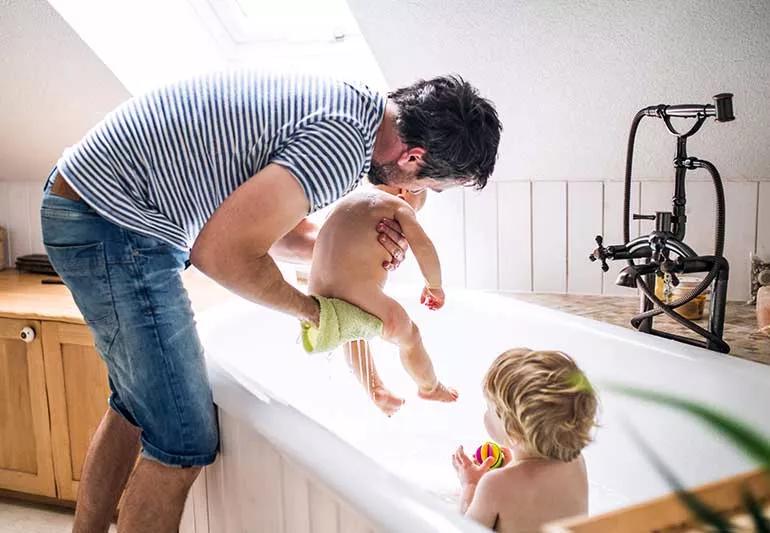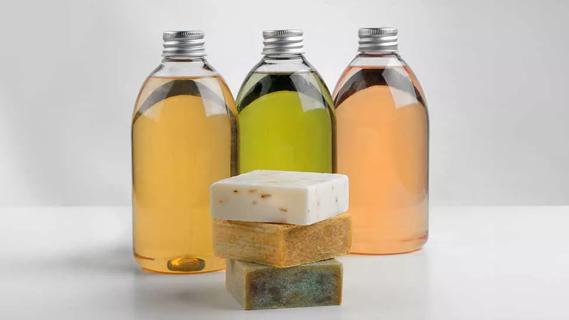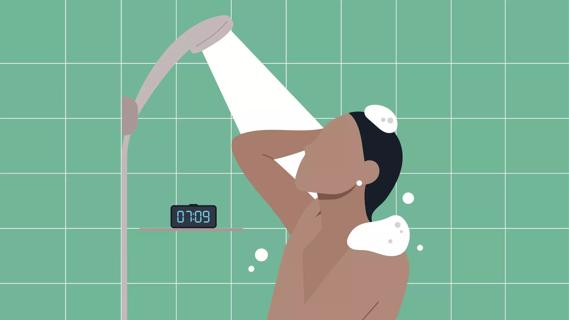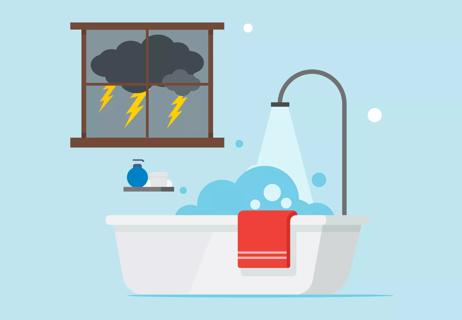Your baby’s skin is more sensitive, so keep the tub water under 100 degrees Fahrenheit

Even when you’re weary at the end of a long day, you know to always bring your A-game to your baby’s bath time.
Advertisement
Cleveland Clinic is a non-profit academic medical center. Advertising on our site helps support our mission. We do not endorse non-Cleveland Clinic products or services. Policy
Sure, you and your kid get to play and bond during tub time. And it’s a big part of helping your baby wind down as part of their bedtime routine.
But it’s also a time to keep your guard up. Because even if you don’t want to think about it too much, all that water and soap bubbles can be a recipe for slips, falls, burns and even drowning.
What temperature is right for your baby’s bath? And what else do you need to know to keep your kiddo safe while they’re scrub-a-dubbing? Pediatrician Maria Tang, MD, shares nine bathtub tips to put your child’s safety first.
Your baby’s skin is more sensitive than yours. So, what you think of as a comfortable and relaxing temperature may be far too hot for your little tot. A too-hot bath can even scald or burn your child’s skin.
A safe and comfortable bath temperature for a baby is no higher than 100 degrees Fahrenheit (about 38 degrees Celsius). You can check for the proper temperature with a bath thermometer, which are available widely in the baby section of many stores and online. Some even double as adorable, bath-friendly toys.
Dr. Tang suggests also testing the water temperature yourself before placing your child in the tub.
“Test the water by dunking your wrist or elbow into the tub, not just your fingers,” she advises. “Your fingers can handle hotter temperatures, so using your elbow will give you a clearer idea of what the water will feel like for your baby.”
Advertisement
Most water heaters have a setting that can keep your water from getting too hot. If you can, consider adjusting yours to no higher than 120 F.
A bath that’s filled to the brim may sound like fun for your splishy-splashy little water baby. But using more than a few inches of water can pose a danger for young children.
The AAP recommends using just 2 inches of water in the tub. That’s because kids can drown in as little as 3 or 4 inches of water if their face gets submerged, Dr. Tang cautions.
The AAP also suggests that the safest method for bathing a baby is using “touch supervision.” In other words, keep at least one hand on your baby at all times during their bath. And remember that babies can be slippery little things when they’re wet. A two-handed approach is probably an even better plan.
It can be tempting to step away from the tub if you’ve forgotten something or want to grab your phone to answer a quick text. But leaving your child alone for even a few seconds is too long, Dr. Tang warns.
If someone comes to the door, take your baby out of the tub and bring them with you. If your older child needs your attention, encourage them to join you in the bathroom or wait for you to finish up.
Before you draw your child’s bath, take time to make sure everything you need is within your reach. Consider things like:
Sure, they’re convenient, but think of bath seats or rings as an extra set of hands, not a replacement for your own. Don’t be lured into a false sense of security or count on any product to prevent drowning. You are your baby’s best source of safety support in the tub.
While toys can be a fun addition to bath time, it’s important to select the right ones.
Skip toys that are too small, as they can pose a choking risk. And steer clear of any bath toys that can retain water, like anything filled with stuffing or that lets water in but not out. Toys can be a breeding ground for bacteria if they aren’t completely drained and dried after each bath. Ewww.
Tub surfaces are slick when wet, which increases your baby’s chances of slipping under the water or bumping their head on the wall. Counteract slippery tubs with a bath mat, anti-slip tape or textured stickers made for the tub. They adhere to the bottom of the tub and provide some resistance to minimize slips and falls.
Advertisement
Dr. Tang also suggests covering hard metal handles, faucets and spouts with silicone covers. This can soften the blow if your child bumps their head or slips and falls against them.
A luxurious bubble bath may sound like a real treat to your right now. But for babies, you want to pass on the bubbles. Bubbles can irritate your child’s sensitive skin. And some people believe bubbles may be associated with urinary tract infections in kids, though the research on that isn’t definitive.
Skip the bubbles and opt for kid-friendly body wash and shampoo (or even a head-to-toe-style wash if you just want to keep one product on hand). Choose an unscented, sensitive-skin variety.
Nothing beats a washcloth when it comes to getting your kid clean. Not sponges or those meshy poofy things. They’re a haven for bacteria if they don’t dry out completely between baths, Dr. Tang says.
Wash your washcloths and towels regularly, as they, too, can build up germs and spread conditions like warts or eczema and contagious diseases like colds and the flu.
It’s not only during bath time that your bathroom presents a risk for curious little kids. Think about what’s in your bathroom: medications, cleaning products, razors, nail polish … all theirs for the taking.
Advertisement
“It’s important to restrict your child’s access to bathrooms by installing locks on bathroom doors and adding latches on toilets,” Dr. Tang states. “Kids shouldn’t be in the bathroom unattended.” (And, hey, those locks could come in handy, too, when you need a moment of privacy.)
Bathtime can be fun. It can be relaxing. And it can be a chance for you and your baby to take some time to bond. Just be sure to keep the temperature comfy for their sensitive little skin and keep a close eye on that slippery nugget.
Advertisement
Learn more about our editorial process.
Advertisement

Often times, sleep training is tougher on the parent than the child

Too much screen time and unrealistic expectations and perceptions and can lead to an increased risk of anxiety and depression

This olive oil-based soap is generally mild and safe when diluted

It’s a wash — when you bathe is a personal preference

They’re nontoxic, but crayons can cause an upset stomach and pose a serious choking hazard

Lightning can strike indoors, even with plastic plumbing — and that includes in the shower

Be mindful about temperature, positioning and efficiency when it’s comes to your little one

Despite unhealthy side effects, 40% of adult Americans still pee in pools

Type 2 diabetes isn’t inevitable with these dietary changes

Applying a hot or cold compress can help with pain